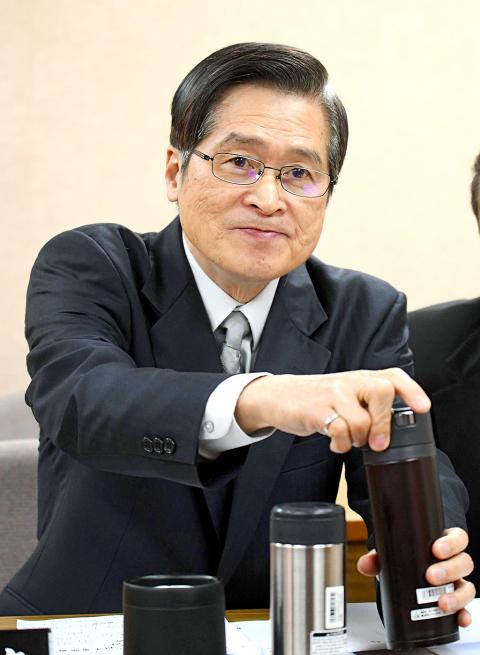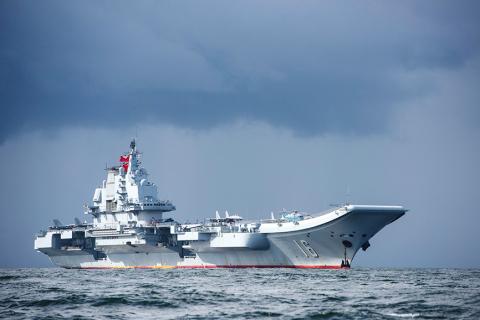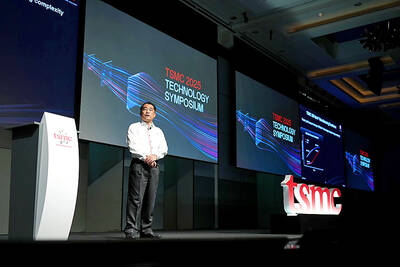The Chinese aircraft carrier Liaoning and its escort warships on Tuesday night again passed through the Taiwan Strait, Minister of National Defense Yen De-fa (嚴德發) said.
Yen confirmed the reports during a question-and-answer session at a meeting of the Legislative Yuan’s Foreign and National Defense Committee in Taipei following questioning by Democratic Progressive Party (DPP) Legislator Lo Chih-cheng (羅致政).
However, Yen declined to comment further on the carrier’s passage, saying only that the ministry had “thoroughly monitored” the event.

Photo: AFP
The Chinese fleet entered Taiwan’s air defense identification zone at about 8pm, sailed southwest to the west of the median line of the Strait and exited the zone at about 12:30pm yesterday, the Ministry of National Defense said, adding that jets and vessels were dispatched to monitor the situation.
Meanwhile, China’s state-run tabloid the Global Times (環球時報) touted the move as Beijing’s response to US President Donald Trump’s signing of the Taiwan Travel Act on Friday last week.
In an editorial titled “Taiwan’s disaster is on the way,” the tabloid criticized Trump for recklessly signing the act and therefore breaching Washington’s “usual practice” that there would be no meetings between US officials and the Taiwanese president, vice president, officials, foreign ministers or defense ministers since the nations severed diplomatic ties in 1979.

Photo: AFP
Trump’s signing of the act has crossed Beijing’s bottom line regarding Taiwan affairs, and in the next five years, China could even go to war with the US over the Taiwan issue, it said.
“It seems [China] is a few more steps closer to annexing [Taiwan] by force,” it said.
Chinese-language The Credere Media yesterday also said the carrier’s passage was China “politically browbeating” Taiwan.
However, DPP Legislator Tsai Shih-ying (蔡適應) said that the proximity of the Liaoning, Trump’s signing of the act and the arrival in Taipei on Tuesday of Alex Wong (黃之瀚), of deputy assistant secretary at the Bureau of East Asian and Pacific Affairs, were likely coincidental.
Missions involving the Liaoning, which travels at a slow speed, take between two weeks and one month to plan, and the Chinese People’s Liberation Army Navy had likely planned the mission to mark the end of the Chinese National People’s Congress on Tuesday morning, Tsai said.
“If China really wanted to intimidate Taiwan, it would likely have docked its warships in the Strait and launched a large-scale military drill. Passing through the Strait would be pointless and not intimidating,” Tsai said.
In response to caution from some Chinese Nationalist Party (KMT) lawmakers that prospective high-level visits between Taiwanese and US officials could escalate tensions, Tsai said that bilateral visits should be conducted like building blocks, starting with lower-ranking officials and gradually rising in the ranks.
“Arranging high-level meetings immediately after the act’s signing could cause ‘the third party’ to misjudge the situation,” he said.
The act would undoubtedly warm Taiwan-US relations and would involve not only the DPP, but also the KMT if it manages to return to government, Tsai said.
Meanwhile, Beijing has warned against any move to “separate the country.”
Chinese President Xi Jinping (習近平) on Tuesday delivered a blistering nationalist speech warning against what he called any attempts to split China.
“All acts and tricks to separate the country are doomed to fail, and will be condemned by the people and punished by history,” Xi said in an address ending the congress.
Ties have turned frosty since President Tsai Ing-wen (蔡英文) came to power in May 2016, as the government refuses to acknowledge that Taiwan is part of “one China.”
Tsai Ing-wen has warned against what she called China’s military expansion — the increase in air and naval drills around Taiwan since she took office.
The Liaoning — a second-hand Soviet-built ship — caused a stir in Taiwan when it first entered the Strait in January last year in what was seen as a show of strength by Beijing. It returned in January this year.
Additional reporting by AFP

DEMOGRAPHICS: Robotics is the most promising answer to looming labor woes, the long-term care system and national contingency response, an official said Taiwan is to launch a five-year plan to boost the robotics industry in a bid to address labor shortages stemming from a declining and aging population, the Executive Yuan said yesterday. The government approved the initiative, dubbed the Smart Robotics Industry Promotion Plan, via executive order, senior officials told a post-Cabinet meeting news conference in Taipei. Taiwan’s population decline would strain the economy and the nation’s ability to care for vulnerable and elderly people, said Peter Hong (洪樂文), who heads the National Science and Technology Council’s (NSTC) Department of Engineering and Technologies. Projections show that the proportion of Taiwanese 65 or older would

Nvidia Corp yesterday unveiled its new high-speed interconnect technology, NVLink Fusion, with Taiwanese application-specific IC (ASIC) designers Alchip Technologies Ltd (世芯) and MediaTek Inc (聯發科) among the first to adopt the technology to help build semi-custom artificial intelligence (AI) infrastructure for hyperscalers. Nvidia has opened its technology to outside users, as hyperscalers and cloud service providers are building their own cost-effective AI chips, or accelerators, used in AI servers by leveraging ASIC firms’ designing capabilities to reduce their dependence on Nvidia. Previously, NVLink technology was only available for Nvidia’s own AI platform. “NVLink Fusion opens Nvidia’s AI platform and rich ecosystem for

Taiwan Semiconductor Manufacturing Co (TSMC, 台積電) yesterday said it is building nine new advanced wafer manufacturing and packaging factories this year, accelerating its expansion amid strong demand for high-performance computing (HPC) and artificial intelligence (AI) applications. The chipmaker built on average five factories per year from 2021 to last year and three from 2017 to 2020, TSMC vice president of advanced technology and mask engineering T.S. Chang (張宗生) said at the company’s annual technology symposium in Hsinchu City. “We are quickening our pace even faster in 2025. We plan to build nine new factories, including eight wafer fabrication plants and one advanced

‘WORLD’S LOSS’: Taiwan’s exclusion robs the world of the benefits it could get from one of the foremost practitioners of disease prevention and public health, Minister Chiu said Taiwan should be allowed to join the World Health Assembly (WHA) as an irreplaceable contributor to global health and disease prevention efforts, Minister of Foreign Affairs Lin Chia-lung (林佳龍) said yesterday. He made the comment at a news conference in Taipei, hours before a Taiwanese delegation was to depart for Geneva, Switzerland, seeking to meet with foreign representatives for a bilateral meeting on the sidelines of the WHA, the WHO’s annual decisionmaking meeting, which would be held from Monday next week to May 27. As of yesterday, Taiwan had yet to receive an invitation. Taiwan has much to offer to the international community’s